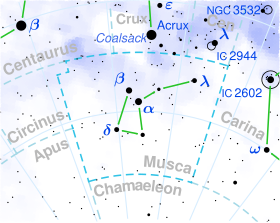Theta Muscae
| Observation data Epoch 2000 Equinox 2000 |
|
|---|---|
| Constellation | Musca |
| Right ascension | 13h 08m 07.15286s |
| Declination | −65° 18′ 21.6819″ |
| Apparent magnitude (V) | 5.53(5.662 + 7.555) |
| Characteristics | |
| θ Mus A | |
| Spectral type | WC5/6 + O6/7V + O9.5/B0Iab |
| U−B color index | −0.91 |
| B−V color index | −0.43 |
| Variable type | Eclipsing + WR |
| B | |
| Spectral type | O9III |
| U−B color index | −0.90 |
| B−V color index | −0.055 |
| Astrometry | |
| Radial velocity (Rv) | −28.4 km/s |
| Proper motion (μ) |
RA: -2.10 mas/yr Dec.: −11.52 mas/yr |
| Parallax (π) | 0.26 ± 0.48mas |
| Distance | 7,400ly (2,270pc) |
| Absolute magnitude (MV) | −6.2 |
| Details | |
| WR | |
| Mass | <11.5 M☉ |
| Luminosity | 230,000 L☉ |
| Other designations | |
| Database references | |
| SIMBAD | data |
Theta Muscae (θ Mus) is a multiple star system in the southern constellation Musca ("the Fly") with an apparent magnitude of 5.5. It is the second brightest Wolf–Rayet star in the sky, although much of the visual brightness comes from the massive companions and it is not one of the closest of its type.
Theta Muscae is a remote triple star system, the primary component of which is a carbon-sequence Wolf–Rayet star. This is a variety of highly-luminous hot blue star that has blown off its hydrogen envelope and is emitting heavier elements, in this case carbon, amid a strong stellar wind. Theta Muscae is the second-brightest such star in the sky after Gamma Velorum in Vela. θ Mus is beyond the current reach of useful visual parallax measurements, but has been estimated as around 7,400 light-years (460 million astronomical units) from Earth. While cataloging the stars in the far-southern sky, French explorer and astronomer Nicolas Louis de Lacaille gave the star its Bayer designation in 1756.
To small telescopes, Theta Muscae appears as a double star, with a blue-cream brighter star and an O9III companion of magnitude 7.3 some 5.3 arcseconds away. The primary θ Muscae A is a massive triple star system.
...
Wikipedia

